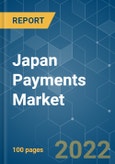The Japan payments market is expected to register a CAGR of 6.4% during the forecast period (2022 to 2027). Payment preferences for e-commerce continue to evolve away from cash and credit cards and toward digital wallets and buy now, pay later (BNPL). The rise of alternative payment methods, volume shifting to credit- and debit-linked digital wallets, consumers opting for interest-free credit in the form of BNPL, and credit-centric verticals like travel still recovering from pandemic impacts are all contributing factors to credit cards' declining share.
The level of rivalry in Japan's payments market is high due to the presence of a large number of market players. Apart from PayPal, some banks, like Japan Post Bank, already enjoy a considerable presence in the payments market, further intensifying the overall rivalry between players. Some of the key players in the Japanese payments market are Mitsubishi UFJ Financial Group, Resona Holdings, and Sumitomo Mitsui Financial Group.
This product will be delivered within 2 business days.
Key Highlights
- Japan has a well-developed e-commerce market that has had consistent growth over time, thanks to high mobile and online penetration and a high preference for online transactions among consumers. Online payments are progressively replacing cash payments.
- Because of the security benefits, Japanese retailers are choosing on-premise digital payment solutions. On-premise digital payment solutions assist businesses in increasing security and, as a result, customer satisfaction. Furthermore, several platforms operate in Japan, offering a diverse range of products and services.
- Cards are the most common method of payment for online shopping in Japan. Prepaid cards, such as BitCash and Mint, are popular in Japan in addition to debit and credit cards. When making an online purchase, credit cards are more likely to be used than debit cards.
- As the Japanese government announced a state of emergency in response to the pandemic COVID-19, the online payment business in Japan has been rapidly growing since the first half of 2020. Furthermore, due to Japan's social distance laws and the closure of many brick-and-mortar establishments, buyers have adopted internet channels even for everyday purchasing.
Key Market Trends
Adoption of online mode of Payments
- E-commerce is growing at twice the rate of POS in Japan's mature economy. Japanese customers prefer credit and charge cards, followed by digital wallets. Bank transfers and COD are expected to lose market share to digital wallets and BNPL by 2025.
- The Japan Payment Clearing Network (Zengin) saw relatively little growth in real-time payment volume and value processing despite expanding the operations window to encompass weekday nights, weekends, and holidays. For consumers, merchants, enterprises, and government agencies, Zengin supports all non-card-based electronic payments, including credit, payroll, remittance, collection, government fines and fees, bonuses, stock dividends, and perks.
- The Amended Payment Services Act of May 2021 in Japan gives non-bank organizations more regulatory flexibility to operate in banking and payment services. This new three-tiered structure for money transmitters encourages non-bank actors to compete and recognizes a new global financial ecosystem with a varied range of economic agents.
Government Initiatives are aiding the growth of the market
- Japan has long been known for its significant reliance on cash, which presents a challenge for banks attempting to move more mundane, low-profit jobs to digital channels. By 2025, the government wants cashless payments to account for around 40% of all transactions, up from around 20% presently.
- The central bank and the country's financial regulator have endorsed a move by Japan's three largest banks to look into the possibility of creating a uniform settlement infrastructure for digital payments. The Japanese are the country's most cash-loving people, with most transactions taking place in notes and coins. Authorities, on the other hand, have been eager to promote cashless transactions in order to boost productivity and, more recently, to decrease human interaction in the wake of the coronavirus outbreak.
- As part of the Digital Currency Forum, a partnership of 74 organisations, Japan's top banks, including MUFG, SMBC, Mizuho, and Japan Post, are collaborating on a digital currency payment system. The endeavour is led by DeCurret, a firm that received USDS 62 million in funding in March from SMBC, MUFG, and SBI. The Proof of Concept (PoC) stage of the project has been completed, and it is expected to be commercialised by March 2023.
Competitive Landscape
The level of rivalry in Japan's payments market is high due to the presence of a large number of market players. Apart from PayPal, some banks, like Japan Post Bank, already enjoy a considerable presence in the payments market, further intensifying the overall rivalry between players. Some of the key players in the Japanese payments market are Mitsubishi UFJ Financial Group, Resona Holdings, and Sumitomo Mitsui Financial Group.
- December 2021 - PayPal is charting a new growth strategy focused on more significant investments, tie-ups, and acquisitions to tap surging demand for cashless payment services. The U.S.-based platform acquired Japanese"buy now, pay later" startup Paidy for roughly USD 2.7 billion.
- October 2021 - Apple Pay was launched by Japanese prepaid cards WAON and nanaco to incorporate e-Money systems into the fold. These prepaid cards were previously only available to Google Pay users. Still, thanks to this collaboration, Aeon's WAON and Seven & I Holdings' nanaco are now available to iPhone and Apple Watch users as well.
Additional Benefits:
- The market estimate (ME) sheet in Excel format
- 3 months of analyst support
This product will be delivered within 2 business days.
Table of Contents
1 INTRODUCTION
4 MARKET INSIGHTS
5 MARKET DYNAMICS
6 MARKET SEGMENTATION
7 COMPETITIVE LANDSCAPE
Companies Mentioned (Partial List)
A selection of companies mentioned in this report includes, but is not limited to:
- Mer Pay Co., Ltd. (MerPay)
- Mitsubishi UFJ Financial Group
- Resona Holdings
- KDDI Corporation (AuPay)
- Japan Post Bank Co. Ltd.
- Rakuten Group Inc.
- NTT Docomo (D-Barai)
- PayPay Corporation
- Resona Holdings
- LINE Pay Corporation
- Sumitomo Mitsui Financial Group
- Mizuho Group
Methodology

LOADING...










